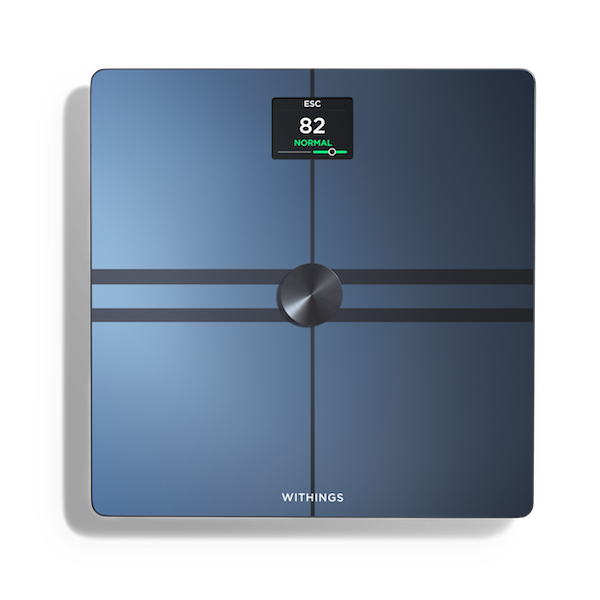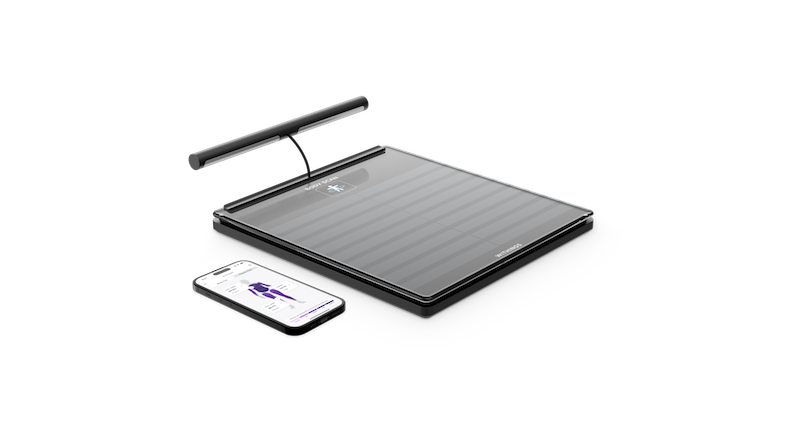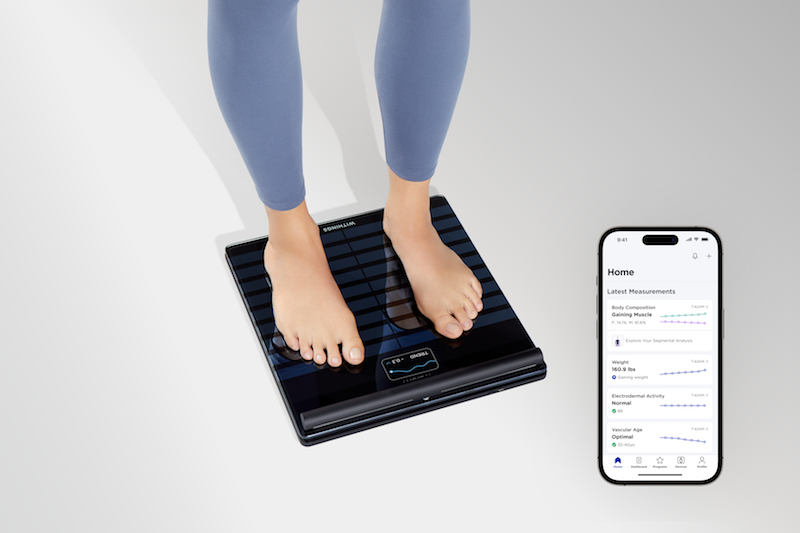Withings is a French technology company specializing in the development and manufacturing of health technology products. It was founded in 2008 and has offices in France, Hong Kong, and the United States. Its product line includes smart watches with health sensors, smart scales, blood pressure monitors, a sleep monitor, and even a non-contact thermometer. Additionally, Withings integrates the data collected by their products with medical professionals so physicians can better manage their patient’s health.
I’ve written several articles about Withings products because I believe they are at the forefront of innovation in consumer health devices. Two examples are the Withings ScanWatch and Withings Body Cardio Smart Scale.
The Withings ScanWatch is a clinically validated heart health monitor. It can perform an on-demand electrocardiogram (ECG), tracks the wearer’s heart rate every second during a workout to optimize training, measures blood oxygen saturation and monitors daily and nighttime heart rates. All of this comes with a full 30-days between battery charging.
The Withings Body Cardio Smart Scale includes technology and sensors so it can not only monitor your weight, but provide you with measurements of your standing heart rate (a general indicator of overall fitness and wellness), vascular age (a health metric that provides a measurement of your arteries’ health and function compared to other Withings users of the same chronological age), body mass index (a screening weight category — underweight, healthy, obese), total body fat, total body water, bone mass, and muscle mass.
Withings has released two smart scales that offer features not previously available in any home health product: the Withings Body Scan Smart Scale and Withings Body Pro 2 Smart Scale.
Withings Body Scan Smart Scale
The Withings Body Scan Smart Scale, winner of three CES 2022 Innovation Honoree Award, builds upon the features available in Withings other smart scales. It offers the following features:

- Precision Weight Measurements – Accuracy of .1 pounds
- Standing Heart Rate Measurement
- Vascular Age Estimation
- Body Composition Measurements – Including Fat, Muscle, and Bone Mass
- Basal Metabolic Rate Calculation – A calculation of the number of calories your body needs for its most basic life-sustaining functions
- Visceral Fat Measurement – Visceral fat surrounds the stomach, liver, intestines and other organs. This is the type of fat most linked to health problems.
- Electrodermal Activity Score (EDA) -This measures and assesses the activity of the sweat glands in the soles of your feet and helps manage your overall health as part of a healthy lifestyle. It is a marker of the effect of your emotions and stress levels on your body and can help you understand your average stress levels over time
- Integration with data collected through other Withings products owned by the user through the Withings App. The app also provides detailed tracking of your health metrics, allows you to set reminders for healthy habits, and allows participation in challenges to keep you engaged. Finally, the app provides integration with other popular health apps including Google Fit, Apple Health, Samsung Health, and others.
- Optional Withings+ Subscription – Purchasing a Withings Body Scan provides you with a free 3-month subscription to Withings+. The Withings+ subscription provides you with an additional health improvement score feature in the Withings App. This feature is designed to help you track your health and wellness goals effectively. In addition, the subscription provides you with additional curated content, including workout classes, articles, recipes, and guided programs.
The Withings Body Scan provides you with the largest number of health biomarkers ever seen on a scale from any manufacturer, including all prior scales from Withings. In addition, what really makes the Withings Body Scan different, is the addition of an integrated handle that pulls away from the main, floor unit, of the scale. This handle provides:
- By using additional sensors in the handle, it allows the user to get much more accurate body composition measurements.
- Electrodes in the handle provide the ability for Body Scan Smart Scale to record a 6-lead Electrocardiogram (ECG). The Mayo Clinic describes an ECG as a test that “records the electrical signals in the heart.” A 6-lead ECG provides a detailed measurement of heart health that is far more accurate and sensitive than an ECG taken with a smart watch. This data can be provided to a physician and could lead to earlier diagnosis of health problems, diagnosis of wider range of heart problems including arrhythmias, nervous system abnormalities, certain medical problems that affect heart function, and may be invaluable in monitoring atrial fibrillation, pacemaker function or the effectiveness of heart medication prescribed by a physician.
Withings Body Pro 2 Smart Scale
The Withings Body Pro 2 Smart Scale offers the same features as Body Scan Smart Scale with a few exceptions. Unlike any other Withings smart scale, Body Pro 2 Smart Scale can only be obtained through a doctor’s prescription. Body Pro 2 Smart Scale leverages the sensors that measure electrodermal activity to help in early detection of diabetic peripheral neuropathy (nerve damage from high blood sugar levels associated with diabetes) and reduce the risk of developing diabetic foot ulcers (skin sores). It doesn’t include the pull away handle so it can’t perform a six-lead ECG or use the sensors in the handle to provide more accurate body composition measurements. It includes a cellular radio and integrates directly with physician offices.

Again, according to the Mayo Clinic, “Diabetes complications can include nerve damage and poor blood circulation. These problems can lead to skin sores (ulcers) on the feet that can get worse quickly.” Poor circulation or nerve damage from neuropathy can impede the body’s ability to heal these foot ulcers and, in some cases, the problem can become so severe that it requires amputation of the affected limb.
Body Pro 2 Smart Scale’s inclusion of technology to detect diabetic peripheral neuropathy in a device that is easily used by someone with diabetes in their own home on a daily basis, is a major step forward in the treatment of diabetes.
Withings also offers a general consumer version of Body Pro 2 Smart Scale called Body Smart Scale. There are a few differences between Body Smart Scale and Body Pro 2 Smart Scale. Body Smart Scale does not include a cellular radio and doesn’t integrate directly with physician offices. Body Smart Scale also doesn’t assist in early detection of diabetic peripheral neuropathy. Instead, like Body Scan Smart Scale, it calculates an EDA to help manage your overall health as part of a healthy lifestyle. Again, EDA is a marker of the effect of your emotions on your body and can help you understand your average stress levels over time
Hands on with Withings Body Scan Smart Scale and Body Smart Scale
Withings provided me with a Body Scan Smart Scale and Body Smart Scale to evaluate for this article.
The scales come well packaged and include a quick-start guide and a more detailed product guide. Body Smart Scale included four AAA batteries while Body Scan Smart Scale included a USB-C cable for recharging its internal battery. Body Smart Scale included supplemental feet for using the scale on thick carpeting. It also included a self-stick, wall mount holder for the handle that alleviates the need to bend over and pick up the handle each time you use the scale. A cable stop that keeps the cable connecting the handle to the scale from retracting into the scale is also included for use when the handle is being placed on the wall mount.
Setup of either scale is very easy. First, you download the app using the QR-Code in the quick-start guide. Next, using the app, create an account. Then, go to devices in the app, press the “+” button, select that you are installing a scale, choose the scale model you are installing, and follow the on-screen instructions to complete the process. These instructions will take you through updating the scale’s firmware and connecting it to your Wi-Fi network.
Once the above process is complete, there are a series of guides that will walk users through the features of the scale, setting modes to tailor the user experience, and more.
Modes are a very interesting aspect of these scales. Athlete Mode can provide people who work out more than eight hours per week and have a resting heart rate below 60 beats per minute (BPM) with more accurate body composition measurements.
Eyes-Closed Mode hides numerical body measurements from being displayed on the scale (they are still available for viewing in the app). This allows a user to focus on trends instead of numerical values.
Weight-Only Mode limits the scale to just measuring a user’s weight. To measure body composition, the scale circulates a small electrical charge through the user’s body. This charge could interfere with a pacemaker or other internal medical device. Weight-Only Mode turns off the measurements that utilize this electrical charge.
Finally, with Pregnancy Mode enabled, the Withings app will provide the user with personalized pregnancy recommendations. Pregnancy mode also turns off the measurements that utilize the electrical charge.
A user can fully customize the information that the scale will display. The scale can display a user’s weight, weight trend, BMI, fat mass, muscle mass, visceral fat, body water, bone mass, heart rate, vascular age, EDA, local weather conditions, local air quality, and steps. Any of these, with the exception of weight, can be removed from display by the scale.
Depending on where you live, ECG data may require a review by a Withings partner before it can be provided to you. This is a no-cost service and simply takes a day or two. Once that review is complete, the detailed ECG is available for viewing in the Withings App. In addition, through the app, the ECG can be securely and privately shared with your doctor, coach, or relatives.
EDA and vascular age require multiple measurements before this data will be available. Until enough data has been collected by the scale, these measurements will simply show as pending in the app.
Like any other scale, you simply step on it to use it. However, unlike a conventional scale, you can only use the scale when barefoot so the sensors in the scale will function. With the exception of an ECG, the scale rapidly completes the measurements and will display them in sequence on the scale’s display. For measurements that will more accurately show trends, Withings recommends that you use the scale around the same time each day.
It is good to understand that performing an ECG with Body Scan Smart Scale takes a full 30 seconds. If you don’t want to take the time to perform an ECG each time you weigh yourself, you can simply disable the ECG in the app until you want to take the added time it requires. Or, since the ECG is one of the last measurements performed by the scale, you can simply choose to step off the scale when it is time for it to perform the ECG.
The details of a six-lead ECG are an advanced topic. Body Scan Smart Scale performs an analysis of the ECG and will inform the user if the reading is normal, or whether it detects issues, such as Atrial Fibrillation (AFib). For those users that want to dig into the details themselves, there is an article in the Withings app that digs into the medical details of an ECG and how it is analyzed.
A second advanced feature that is only available with Body Scan Smart Scale is segmental analysis of body composition. This allows you to see how muscle and fat is distributed on your arms, legs, and torso.
One thing to be aware of when using Body Scan Smart Scale is that there are two sets of electrodes on the handle. The first is on the far side of the handle and is engaged as you wrap your fingers around the handle. The second is on the close side of the handle for your thumbs. When I first tried using the scale, I had a band-aid on one of my thumbs. This disrupted some of the scale’s measurements because that one thumb was insulated from the sensor. Again, this is just something to be aware of when you use the scale
Both scales also support setting weight goals including losing weight, stabilizing your weight, gaining weight, losing fat mass, and gaining muscle mass.
Both scales also support multiple users. Through the app, a link can be sent to another person through email, text message, etc. The person can then use that link to set the scale up in their Withings app. Then the scale will learn to recognize them by having them shift their weight from side to side while standing on the scale. Children under 16, who don’t have their own Withings account, can also be setup to use the scale.
The Withings app allows you to dig into the details of the measurements provided by these scales. For example, using Body Scan Smart Scale the app can graphically display the distribution of muscle and fat on your arms, legs, and torso. When using either scale, the app can display the different components of body composition measured by the scale over time. This includes muscle mass, fat mass, visceral fat index, lean mass, and water mass. Each graph has a small “?” button that provides detailed information, in an easy-to-understand format, on that measurement, its implications on a person’s health, and steps a person can take to improve.
Overall, both scales worked perfectly. They provide advanced medical diagnostics, previously only available in a doctor’s office, that allow the users to better manage their health.








